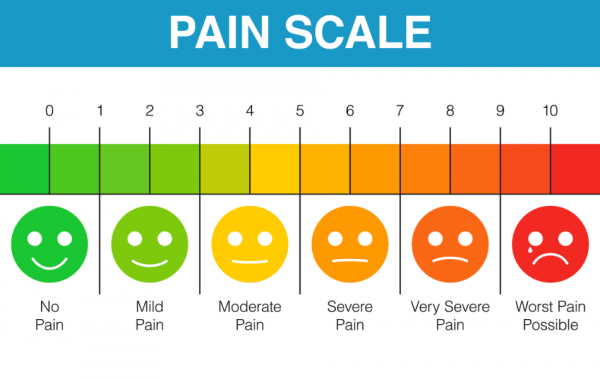Wishing everyone happy holidays and a joyful New Year from the Healthify team. Don't forget to Slip, Slop, Slap and Wrap!
Pain – describing your pain
Ways to describe and document your pain
Key points about describing your pain
- Describing your pain accurately can help your healthcare provider make the right diagnosis and best treatment plan for you.
- It helps to understand the difference between acute pain (which comes on over a short period of time and has a specific cause, such as a broken bone or cut) and chronic or long-term pain (which lasts longer than 3 months, such as arthritis).
- Find out how to prepare for your healthcare appointment by thinking about how to describe your pain.
- You can also learn how to use a pain scale and pain diary.

Describing your pain accurately can help your healthcare provider make the right diagnosis and create the best treatment plan for you. The kind of pain you have can tell your healthcare provider:
- where it could be coming from
- what might be causing your pain
- what tests need to be done to find the cause
- how long it might last, and
- what treatment is likely to help.
Pain can make it hard to think. It helps to plan how to describe your pain before your appointment. You don't need to use medical words.
It helps to be able to understand the difference between acute and chronic pain as the management can be different for each.
Acute pain comes on suddenly and has a specific cause. It usually doesn’t last longer than 3 months and stops when the cause of the pain is treated. Chronic pain lasts longer and can stay even after the original cause has gone away. Sometimes chronic pain comes from a problem with your body’s pain system itself, even when there’s no previous injury or damage. Read more about what pain is.
To help you describe your pain and talk about how it affects you, think about your answers to the following questions before you have your appointment with your healthcare provider.
- Where do you feel the pain?
- How long have you had your pain?
- How did it start?
- How often do you get it?
- Is your pain in one spot or spread out?
- Does it come and go, or is it there all the time?
- How does it feel? (See below for some words to help you describe your pain).
- How bad is it? (See the rating scale below).
- What makes your pain feel better or worse?
- Does it come with other symptoms, such as nausea or joint stiffness?
- Have you ever felt this pain before?
- How does your pain affect your daily life?
Each person experiences pain differently. Describing your pain accurately is important as it can help your healthcare provider make the right diagnosis and develop the best treatment plan for you. Here are some examples of words that can help you describe the way your pain feels – you can use a combination of these words.
| Words to describe your pain | |
|
|
Some people find using descriptive sentences helpful, for example ‘like a red hot needle’ or ‘like a tight band’.

Image credit: Canva
A pain scale is a way of recording how strong or severe your pain is using a form or a visual image. You might choose:
- a number (eg, 7 out of 10)
- a face with a sad or happy expression
- a word (eg, mild or severe)
- a point on a plain line where one end means no pain and the other end means the worst possible pain – you put a cross (x) or a circle to represent your experience of pain.
The image below combines the first 3 options into a single rating scale. On this scale, 0 out of 10 means you have no pain at all, and 10 out of 10 means the worst possible pain. The middle (about 5) is moderate pain.

Image credit: Depositphotos
You may be asked to rate your pain using the pain scale on your 'best day', 'worst day', and on an 'average day'. This helps your healthcare provider get a clear picture of how your pain level changes each day – or even within a day.
Sometimes people have trouble describing their pain. This may apply to young children, people with intellectual difficulties, or where there are language or communication barriers. In these cases, your healthcare provider may look for other signs to assess your pain. These include:
- crying
- facial changes (eg, grimacing or frowning)
- changes in sleeping or eating patterns
- becoming quiet and/or withdrawn
- screaming or refusing to move.
The faces pain scale, as pictured above, can also be used. The person in pain can point to the facial expression that represents how their pain makes them feel.
If you have chronic pain, it can be helpful to take a pain diary with you to your appointment. Keeping a pain diary and tracking how your pain affects your daily activities can be a useful way to help you understand the pattern of your pain. It can help you notice things that make your pain worse (these are called triggers) and what helps to relieve your pain, and describe to your healthcare team how your pain has been affecting you over time.
You can record your pain information in:
- a notebook
- pain diary(external link)
- apps for pain on your mobile device.
While keeping a record of your pain is important, it's not necessary to record every moment that you experience pain. This could cause you to become too focused on your pain. Instead, try making an entry in your pain diary at certain times throughout the day, such as in the morning, at midday and before bed. This will help you keep a regular record of events which will provide valuable information about your pain and its management.
Information to record in your pain diary
Date and time:
- Make a note of the date and time you get the pain.
Describe your pain
- Describe the location of your pain – where is it?
- Does it move? Does it stay in the same place or does it spread?
- How long does it last?
- What does it feel like? See the section on words to describe your pain.
Rate the severity of your pain (how bad it is)
- You may find it helpful to rate your pain using a scale from 0 to 10, where 0 out of 10 means that you have no pain at all, and 10 out of 10 means the worst possible pain. The middle (around 5) is moderate pain. See how to use a pain scale.
Things that make your pain worse
- Write down the things that make your pain worse – this could be activities you do, things you eat, etc.
Things that make your pain better
- Make a note of things that relieve your pain (make it feel better) and help you get through the day.
- This could be things like rest, pain relief medicine or complementary and alternative therapies.
- If nothing helps, say so.
Anything else
- Write down anything else that you notice about your pain or the pain relief that you use. For example, do you notice any side effects from your pain relief medicine? Does it work better at some times than others? Did your pain stop you doing something?
Apps reviewed by Healthify
You may find it useful to look at some Pain management apps.
Pain - general topics
Te Kete Haerenga and pain
Te Kete Haerenga – wellness toolkit These should be used together
The Pain Toolkit(external link) Pete Moore, UK
Improve your pain management by keeping a pain journal(external link) Pain Treatment Centers of America, US
Navigating pain(external link) New Zealand Pain Society
Apps
References
- Acute vs chronic pain(external link) Cleveland Clinic, US, 2020
- How to talk to your doctor about pain(external link) Cleveland Clinic, US, 2020
- How to describe pain(external link) Autoinflammatory, UK, 2019
- The principles of managing acute pain in primary care(external link) BPAC, NZ, 2018
The principles of managing acute pain in primary care(external link) BPAC, NZ, 2018
Faces pain scale – revised(external link) IASP, US (other language versions available)
Identifying pain(external link) Department of Health, Victoria, Australia (includes pain assessment tools)
Pain assessment and management | Te aromatawai me te whakahaere mamae(external link) HQSC, NZ
See our page Pain (chronic) for healthcare providers
Apps
Credits: Healthify editorial team. Healthify is brought to you by Health Navigator Charitable Trust.
Reviewed by: Dr Emma Dunning, Clinal Editor and Advisor
Last reviewed:





